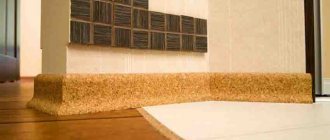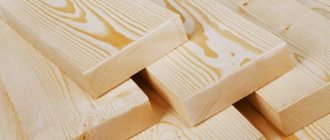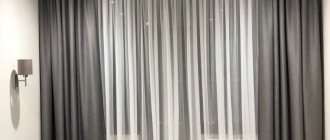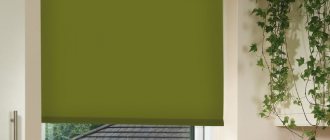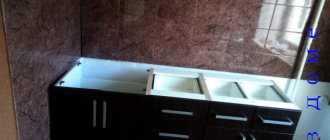“How to combine different types of flooring?”
“What is a cork expansion joint and what is its purpose?”, “How to install a cork expansion joint?” - questions asked more than once by consumers during the construction of private houses or renovation of an apartment with their own hands. When renovating apartments and building houses, great attention is paid to floor coverings.
When you come to visit, the first thing you notice is the floors. They are the ones who create the first impression about the people living in the apartment, their well-being, neatness, and hard work.
General information
Coating properties
Floors are exposed to pressure from walking and furniture, therefore, in order for coatings to serve for a long time, it is necessary to take into account their purpose in different rooms of an apartment or private house.
Each room of the apartment: room, corridor or kitchen requires the installation of its own floor covering. So, in rooms, the main thing for flooring is comfort and coziness; in the kitchen, the floors are often washed and exposed to chemicals, so it is better to lay them with ceramic tiles. In the corridor, flooring must be durable.
Floors made of different materials must be joined together. For a smooth transition from one floor covering to another, thresholds made of rubber or other elastic material are used. But these materials do not justify themselves; over time, they become rigid and lose elasticity, disrupting the harmony of the interior.
A way out of this situation may be a joining profile, which is popularly called a cork compensator or cork separator. Its installation will help compensate for the expansion of the floor, relieve tension between different materials and make the seam between them invisible. Today we will tell you what a cork expansion joint is, what it comes in and how to install it at the junction of different floor coverings.
What is a cork compensator
A cork expansion joint is a strip of crushed cork tree bark 7 mm thick, 15 mm high and 900 mm long. The end of the strip is coated with special paint and water-based polyurethane varnish. The color range of cork expansion joints is varied; a wide range of shades allows you to choose the desired color of the joint of floor coverings.
The cork expansion joint makes it possible to fill the seam between two floor coverings, making the difference between them less noticeable and not noticeable. A contrasting cork will emphasize the dividing line of rooms or zones in rooms, giving the apartment an impressive, stylish look.
In addition, the cork expansion joint, filling the gap between floor coverings, prevents the destruction of materials and protects them from mechanical impacts. The cork compensator can be used both in one room and in different ones.
Why is it necessary to join floor coverings in one room?
Recently, zoning of rooms has become widespread. Zoning is done both with the help of partitions, curtains, and by using several floor coverings in one room, for example, tiles and laminate. The room can be divided into dining and kitchen. The dining area will be laid with laminate, and the kitchen with tiles. This design solution using a contrasting cork expansion joint will divide the room into zones.
Designers propose to visually increase the space of the room through the use of laminate and tiles in the hallway. A cork expansion joint will highlight the features of the apartment’s interior.
The combination of two floor coverings in one room is practical. So, for example, you can lay ceramic tiles at the front door, and then laminate throughout the entire corridor. A cork expansion joint will help make the joint between them invisible.
Using two floorings in one room will save you money because tile is much more expensive than laminate. A stylish solution will amaze your friends and make your interior creative and fashionable.
Advantages of a cork compensator
The cork compensator has a number of advantages:
- Cork is a natural, environmentally friendly material that does not emit harmful substances. Natural components used to make cork expansion joints make it possible to use it in apartment buildings, cottages, and public buildings. When the material burns, chlorine, phenol and other hazardous substances are not released. To prevent the cork from burning, it is treated with a special substance. Naturalness and environmental friendliness make the material reliable and safe. Disposal occurs naturally.
- Thanks to its pores in the granules, cork has low thermal conductivity, helping to retain heat in the apartment.
- The cork compensator does not allow loud sounds to pass through, dampening them. It can absorb noise with a power of 27 dB
- In addition, cork is resistant to high and low temperatures. At negative temperatures it does not lose its properties.
- The water resistance of the cork will allow you not to worry about it; it will not deteriorate even in high humidity.
- One of the important properties of a cork compensator is to reduce the level of radioactive radiation.
- Cork expansion joint is a natural antiseptic that protects floor coverings from insects, rodents, rotting, and mold. Therefore, there is no need to fear that ceramic tiles, parquet, laminate in contact with the cork expansion joint will begin to deteriorate under the influence of harmful microorganisms.
- The compensator strip is not exposed to ultraviolet radiation, does not transmit static electricity and does not accumulate it.
- The variety of colors of the compensator strip helps to choose the same tone of the material in order to veil the sharp transition from one floor covering to another. The cork expansion joint can be easily painted in any color using light-resistant tints, which makes it possible to obtain a shade of any intensity.
- The cork compensator is easy to install and simply dismantled. Any person who is far from construction and does not have professional flooring skills can handle the installation of the material.
- Cork expansion joint highlights the best aspects of floor coverings, giving them style and attractiveness.
- The cork expansion joint will last a long time: it does not sag, does not get trampled, quickly contracts and returns to its shape, because the material is elastic and elastic and is not subject to hardening.
- The material is universal because it is used for various types of flooring: laminate, ceramic tiles, parquet.
Types of thresholds
Such a variety of profiles makes it difficult for property owners to choose. To make this process easier, we recommend that you familiarize yourself with the classification of thresholds for tiles and laminates. They are divided into several categories; we’ll talk about each type in more detail later.
Not every joint can be designed independently: in some cases it is better to delegate the work of finishing the gap to a professional.
According to the profile section shape
In most cases, the latter option is used for tiles and laminate. It supports operation with multi-level floors.
One of the types of threshold used when joining laminate and tiles is called final.
By installation type
There are models of thresholds for porcelain stoneware and laminate that do not require the use of a drill. But as a rule, in apartments the following connecting component is used:
- Steel profile with through fastening. It looks like a special strip with which the joint is covered. A strip of metal presses the edge of the joint to the floor surface. For fixation, self-tapping screws with a hidden head are used. The profile is ideal for decorating different levels of materials or in case of imprecise cutting. It is necessary to seal loose edges with silicone sealant;
- H-shaped design. This variation does not require drilling. To connect, the bottom shelf is inserted behind the panel, after which the tile is inserted into the opposite groove with an adhesive base. The gaps are treated with a special mixture for tiles, and the side of the laminate is filled with a reliable sealant. Very often this is done with acrylic or silicone compounds;
- Demountable H-shaped panel. It is represented by two T-shaped structures, which are fixed to each other using special legs. Once installed, the top decorative piece is placed into the bottom clamp until it snaps into place.
The most common type of cracks that need to be sealed.
The choice of products from this range is based on preferences for the installation method and the type of floor finishing materials.
Such seams are most often finished with the help of additional elements - thresholds.
Based on materials
An equally important aspect of the issue is the raw materials that were used in the manufacture of thresholds for tiles and laminate. Therefore, the quality of the product must be checked before purchase and installation. There are cork products used to connect two different materials. They are more environmentally friendly and expensive. Therefore, they are used in repairs extremely rarely, for example, to decoratively hide small joints.
As a rule, fractures are caused by the fact that the tiles are not trimmed and the laminate is laid end-to-end against them.
There are also rubber, that is, rubber options. The composition includes polymers, which allows for elasticity. But the most popular solutions are steel, aluminum and PVC. We will talk about them in more detail.
This ensures a harmonious appearance of the entire coating.
Metal
Flexible metal profiles are used in wavy curves, but can also be used in straight joints in a room. To ensure resistance to wear, a special powder layer is added to them. It protects products from mechanical damage.
Chrome-plated parts with a mirror coating, which retains its performance properties for many years, have an attractive and impressive appearance.
Aluminum
- with holes for fasteners (screws);
- hidden fastening;
- self-adhesive variations.
High mechanical strength, corrosion resistance, and durability make such products the most popular.
The choice is based on the preferences of the apartment owners and the final result.
How to choose?
Types of cork compensator
It is available in solid and liquid form.
Hard material
It consists of strips from 90 cm to 3 m long, up to 10 cm wide and 15-22 m thick. The cork is covered with 7-10 layers of polyurethane varnish, which protects it from exposure to adverse environmental conditions. It is painted in different colors and is used to treat the joint between laminate and tiles. It is made from cork oak bark, which is pressed in special heat chambers. No chemicals or glue are used during the production of the cork expansion joint.
The material is cut into the shape of a narrow sill, which is inserted into the joint between the floor coverings to create a single-level expansion joint. You can use a natural color compensator when sealing joints. In this case, it is tinted in the color that is closest to the coatings. You can also use colored cork expansion joints.
Liquid type of compensator
It is a mixture of elastic cork mass, glue and solvent. Available in 500ml packages, carefully sealed.
The liquid compensator does not shrink and does not delaminate due to high weight load. The liquid plug between the floor coverings helps them move freely. At the same time, increasing or narrowing the laminate does not affect the appearance of the surface. Liquid cork can also be used to eliminate squeaks in parquet flooring by closing the gaps between the slats.
The disadvantage of liquid cork compensator is the high speed of setting of the material, so it must be installed quickly so that it does not harden.
Where is liquid stopper used?
The scope of application of liquid cork compensator is wide. In addition to its main purpose: finishing joints between floor coverings, it is also used in other construction work.
- Liquid cork is indispensable when processing floor seams in recording studios. It has high soundproofing properties, so the work of the studio is not disturbed by extraneous noises and sounds.
- The use of liquid cork expansion joints when sealing seams in partitions between rooms increases sound insulation.
- Liquid cork sealant helps seal cracks when installing windows and doors, helping to retain heat in the apartment and eliminating drafts.
- If the house is panel, then liquid cork also helps to seal the seams between them.
Requirements for using a cork expansion joint
The cork expansion joint gives the transition between two floor coverings a decorative appearance when strict requirements are met in relation to the joint between the laminate and the tiles.
- the edges of the mating sides of the floor coverings must be smooth, without flaws;
- the laminate must be treated with a special agent to prevent moisture from penetrating inside;
- If the tile approaches the joint with the cut side, it is carefully sanded. But no matter how the surfaces are sanded, when joining floor coverings, small micro-cracks are visible that form during the cutting of laminate flooring and tiles. They are filled with sealant. The sealant additionally protects the laminate from moisture;
- The cork expansion joint is cut to height using a sharp construction knife.
Advantages and disadvantages
The cork compensator has the following advantages:
- Highly environmentally friendly material. It is made only from natural materials and can be easily recycled if dismantled.
- Safety. The material does not contain toxic or allergy-causing substances. The installation process also does not put workers at risk.
- Easy to install. If you choose the correct size and thickness of the plug, installing it will not be difficult.
- Ability to shrink. A cork with a thickness of 10 mm can be reduced to 7 mm in case of expansion of the adjacent material, while it retains all its properties.
- Durability. Cork coated with more than one layer of varnish is especially durable.
- A wide range of colors, which allows you to make the transition between different floor coverings as invisible as possible.
- Good thermal insulation properties. The cork strip will not be cold.
- Versatility. This compensator will fit perfectly into any coating.
- Due to the fact that the cork bends, it can be installed in a seam of any shape.
However, this material also has its disadvantages:
- Low moisture resistance. If a large amount of water gets in, the expansion joint may swell, so it is not recommended to install it in places where moisture can accumulate, for example, in the bathroom or kitchen. However, it is possible to treat it with a special sealing compound to avoid this problem.
- Also, cork materials can absorb and retain odors when liquids come into contact with them.
Therefore, cork expansion joints are used in areas where there is no risk that the cork will be constantly exposed to moisture.
Installation of a cork compensator
Installation of the cork compensator occurs in a certain sequence:
- It is necessary to clean the joint between the floor coverings from dirt and dust.
Important! The joint between the lamellas along its entire length should be the same width and depth. The cork expansion joint should rise no higher than 1 mm from the floor level. If the material protrudes above the floor level to a greater distance, then the seal must be cut off.
- Fill the gun with construction adhesive (liquid nails) and apply it to the edge of the laminate along the entire length of the seam.
- Place the cork expansion joint at an angle to the edge of the laminate. Do not lower the material all the way down, but glue only the end. Press the compensator so that the glue sets, insert a can of sealant for parquet or acrylic-based wood into the gun. Lift the upper part of the cork expansion joint, bend it and fill it with sealant. The sealant protects the laminate from environmental factors, mainly moisture. It seals the cut edges of the laminate along the entire seam and glues the expansion joint.
- Take a sponge dampened with water and wipe off any excess glue. At the same time, keep a bowl of water nearby to rinse the sponge. Wipe the threshold with a dry cloth.
- Next, lay the tiles after installing the laminate and cork expansion joint to bring it to the same level as the laminate. To install tiles, use special adhesive.
If the joints between floor coverings exceed the maximum length of the cork expansion joint of 0.9 m, then several strips are laid along the seam. The material is flexible and elastic, so it is successfully used for curved joints. Installing a liquid plug is slightly different from installing a solid expansion joint.
- First of all, you should remove construction debris from the joints, remove dust from the seam, and degrease the surface. It is best to coat it with a primer.
- Then apply masking tape to the joint between the facing surfaces.
- The temperature at which the liquid cork expansion joint should be installed should not be lower than + 5 degrees. Pour the liquid stopper from the tube into a wide container. Using an air gun or putty knife, fill the joint with liquid cork expansion joint. Cut off the remaining sealant with a spatula or a sharp construction knife. Wait for the compensator to dry. Its drying time is 24-48 hours.
- Remove the masking tape, use a sponge to remove excess cork, and wipe the surface dry.
Attention! It is very important to distribute the expansion joint evenly along the seam. Inaccurate work will lead to the appearance of defects that are unlikely to be corrected after the seal has dried.
Important! To prevent the cork expansion joint from crumbling over time, it is better to treat it with varnish or wood antiseptic to protect the top layer of the surface of the material.
Methods of joining without a threshold
With changes in temperature and humidity, materials can expand, especially laminate. Therefore, a gap between these materials is required. It must be filled with some elastic material.
Cork compensator
This material is a strip of cork. On one side it can be either painted or covered with a layer of natural wood veneer (in this case the cost is more expensive). The standard length of the material strip is 900 mm, non-standard - from 1200 mm to 3000 mm (on request), width - 7 mm or 10 mm, height - 15 mm, or 18 mm, or 20 mm, or 22 mm. When the joint is located under a doorway, a standard length of material is usually sufficient.
Installation of a cork compensator
Before installation, you need to determine the dimensions of the compensator strip. The height should correspond to the thickness of the floor covering, the width to the width of the gap. The permissible joint width between tiles and laminate is 1 cm.
For installation, do the following:
- clean the edges of tiles and laminate to eliminate cracks and chips;
- remove dirt and dust from the floor;
- coat the gap between the tiles and the laminate with glue;
- place a compensator in the gap, fix the end edge;
- lift the strip from the laminate side and pour in a small amount of sealant;
- remove excess sealant using a wet cloth;
- If the compensator strip protrudes above the floor surface, cut off the excess with a knife.
If the end strip of the cork expansion joint is not covered with veneer, then after the sealant and glue have dried, the end edge should be sanded and varnished.
Grouting joints
The pre-laminated edge is coated with silicone. The same material fills the joint to two thirds. After the silicone dries, the unfilled part is filled with a material called joint grout. After application it should be leveled.
Liquid plug
This relatively soft connector is a sealed material consisting of balsa tree bark chips mixed with a water-based bonding solution. The joint is obtained with the texture and color of cork. Thus, when using this material, three functions are performed: filling the seam, creating a natural and pleasant appearance, and protecting the joint from moisture.
To seal you need to do the following:
- to begin with, you can stick masking tape along the borders of the joint;
- the seam is filled with material either from the tube in which it is packaged, or using a spatula;
- cut off excess, level the surface also using a spatula;
- remove the masking tape with any remaining material;
After this treatment, the liquid plug should dry. This lasts from 24 to 48 hours.
Main manufacturers
Liquid cork compensator is produced in France, Russia. The leader in sales of liquid cork is France.
France, Germany, Portugal, Poland produce a solid cork compensator in the form of a threshold. The material is made from cork oak grown on plantations in the Mediterranean and Caucasus.
The most famous brand of threshold compensators is EGEN Poland. The material is of high quality and practicality. Cork expansion joints are also produced in sheets, the most popular brand of which is Amorim, Portugal. Liquid cork expansion joints of the brands Isocork, Nanocork (Russia), Bostic (France) are popular among buyers.
The Portuguese manufacturer Cortex makes an inexpensive cork expansion joint. The price of a 15 mm wide compensator costs 80 rubles per linear meter, and a 22 mm wide compensator is sold for 90 rubles per meter.
The Russian company produces high-quality cork expansion joints at a price of 200 rubles per linear meter. The high quality of the material allows you to seal the seam between laminate and tiles, tiles and tiles, parquet boards and tiles neatly and reliably.
Features of various docking devices
Metal joining profile Connections between tiles and laminate are made using products made from different materials, aimed at different customer segments and having their own scope of application. Among these devices, the following should be highlighted:
- Metal profiles (aluminium, brass, steel). These devices are widely used for joining tiles and laminate flooring; they have an affordable price and various color variations. You can choose a profile to match the color of the laminate or the same tone as the door handles. Metal joining is convenient to use on straight connecting sections.
- Plastic strips. This material is the most budget-friendly. It is sold in roll form and can have different shades. It is convenient to use plastic on wavy joints, since the product bends well. Its disadvantages include fragility and loss of appearance after some time.
- MDF moldings.
They fit perfectly under laminate, cover the joint well and have an attractive appearance, but they are afraid of moisture and quickly lose color. Cork expansion joints - Wood products. Widely used to connect wooden flooring to another type of floor. These planks have an excellent appearance and a good price, but require periodic maintenance. The joint needs to be repainted and sanded from time to time to maintain the appearance of the room as a whole.
- Cork compensator. One of the popular modern materials widely used for connecting laminate and tiles. The cork strip fits into the gap between the materials, thereby creating a threshold-free joint that has an excellent appearance and is easy to use.
Some types of butt joints are presented in the table.
It is an adhesive structure into which cork is added, and after hardening the connector looks like a cork expansion joint.
Cork expansion joint instead of baseboard
Recently, an innovation has become popular: using a cork expansion joint instead of a baseboard when edging parquet. In this case, it is necessary to select the tone of the parquet and compensator. It could be oak or walnut.
The tones can also be contrasting to highlight the parquet base. When laying parquet, you need to approach the wall no more than 10mm. This gap is made so that the cork expansion joint fits properly and neatly. The area where the parquet meets the wall must be level. To level the edges of the parquet, a round lamellar router is used. Next, the surfaces of the coatings are cleaned of dust, shavings, wood, one side of the cork expansion joint is smeared with glue and pressed in. Next, the entire surface is sanded.
Liquid stopper for joints
When construction, repair, and finishing work is carried out, there is a need to use a building material such as liquid cork, which has noise-insulating and insulating qualities, and is also applicable as a sealant, that is, it does not allow wind, rain, and excess water to penetrate through the window frames during the cold season. sounds This finishing material is also used for decorative coatings.
Not everyone can afford to purchase natural cork for renovation or construction. It is a fairly expensive building material. A good alternative is liquid plug, which is formed from fine crumbs.
Liquid stopper for joints
Advantages of liquid plug
- is environmentally safe;
- has mechanical stability;
- good thermal insulation;
- excellent adhesion to absolutely any surface;
- not susceptible to temperature changes.
This finishing material is quite elastic and does not settle. It can be safely used without any particular fear that the main finish will be damaged. It is successfully used for sealing gaps between coverings, such as walls and parquet, tiles and plastic panels, and laying parquet. Ideally eliminates cracks and evenly presses on parquet boards, which allows you to use the coating without any obstacles.
Using this sealant will also eliminate the unpleasant creaking that may appear in the parquet over time. We can also use this building material for joints between laminate and tiles.
Features of using liquid plug
it is very important to follow the order of laying laminate and other coatings; first lay the tiles, and only then the laminate; when laying floor coverings, the cut line must be straight; When the building materials are properly joined, the cracks are sealed with liquid plug.
Thanks to the effect of this finishing material, the joints that are formed between the coatings will be thoroughly sealed, because it is quite elastic. This sealant is also used as insulation for windows and doors, after which absolutely any drafts will no longer appear in the house.
Since this finishing material contains air, the sealing composition has good thermal insulation properties. This building material is also used as the main one - for treating indoor walls. It is used for both internal and external repair work. The technology for using this sealant is not the most difficult when applying it to walls.
Features of liquid plug
- has the ability not to absorb water, maintains vapor permeability;
- creates a magnificent exterior;
- provides powerful sound and thermal insulation.
The use of building materials in repair work helps eliminate more than one problem that has arisen. Using this material, you have the opportunity to do everything yourself without spending money on calling a specialist to your home.
This sealant significantly reduces street noise and vibration to a level that is acceptable to human hearing. Water vapor, which easily penetrates this building material, improves the microclimate in the rooms. When indoor air humidity increases, steam leaks through the walls to the street, so there is no need to install a ventilation system.
When working with such finishing material, you need to prevent it from getting on open surfaces, because this will complicate the cleaning process. Once the composition dries, this is simply impossible to do. This building material should not exceed the surface of the flooring. It, in combination with construction adhesive, has good resistance to moisture. When using it, there is no need for additional fixation, that is, the use of self-tapping screws.
The permissible seam width for filling joints with building material should be from 5-15 mm, no less. Before applying liquid cork to the cracks, you should remove accumulated debris and dust from them.
In conclusion, we can say that after using this sealant for construction and repair work, even a specialist of the highest class will not regret it.
remontidoma.ru
Prices for cork expansion joints
The cost of cork expansion joints is low.
The price of a solid cork seal ranges from 100 to 150 rubles per piece. A sheet compensator costs 1000 rubles per sheet. The cost of liquid compensator depends on the region and manufacturer. The price range for liquid stopper is from 160 to 200 rubles per 0.5 liter package.
You can buy a cork compensator in all cities of Russia: Penza, Samara, Yekaterinburg, Voronezh, Moscow, St. Petersburg, Tyumen, Kazan, Kaliningrad, Krasnodar, as well as outside our country: in Minsk, Kiev and others. Leroy Merlin consultants will help you choose the right building material.
Using Liquid Stopper
An example of applying a liquid compensator using a gun The only mandatory condition for using a liquid compensator is the requirement for surface preparation.
It should be dry and fat-free. It is recommended to treat it with a primer before filling. Liquid linoleum: installation technology and pricing
An ordinary spatula or air gun is suitable as a tool.
A panel of ordinary wallpaper
Oddly enough, instead of a plinth, you can also use a strip cut from wallpaper. Its width is about 20–25 cm. The main requirement in this case is that the panel should be noticeably different from the main finish. It may contain contrasting patterns and complex patterns. When laying panels, you can also visually raise the ceiling.
In addition, instead of such a product, you can use ordinary paint. It is simply used to draw a line along the perimeter of the walls close to the ceiling. The effect is similar. Only in this case the strip will be the same shade and without patterns. In general, this framing option is great for large rooms or those rooms in which the ceilings are initially too low.
Results
When using materials similar to floating floors and expansion joints, you must follow safety rules. It is necessary to understand that wood impregnated with chemical mixtures is a flammable material. Therefore, when purchasing such products, it is worth carefully studying their characteristics.
Application example of a balsa wood expansion joint
It would also be a good idea to consult with an expert and familiarize yourself with the documentation that will confirm the quality and safety of the material. It is worth leaning towards purchasing products from already proven manufacturers who have managed to gain the trust of customers in the market.
When is liquid stopper used?
Manufacturers also offer a compensator in the form of a liquid mixture. The liquid plug between the two facing materials allows the coating to move freely. At the same time, the expansion and contraction of the laminate does not affect the appearance of the surface.
Liquid cork is used to close gaps in parquet flooring, remove squeaks and restore the floor to its original appearance. It is successfully used not only for parquet, but also for places where it is necessary to install protection from noise and high humidity, while retaining heat.
No special skills are needed to work with liquid plug. The main thing is to adhere to the basic requirements (clean the surface of dirt and dust, dry it and treat it with a primer).
However, liquid plug also has disadvantages. After installing it in the room, you will have to do a general cleaning.
